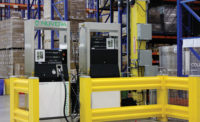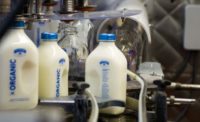Sustainability, environmentally responsible, wastewater treatment and energy efficiency are all important facets of a modern day cold food and beverage manufacturing facility. But, how do these qualities equate to the future of cold food processing?
Refrigerated & Frozen Foods interviewed WhiteWave Foods, Sanderson Farms, OSI Group, General Mills, Smithfield and Sabra Dipping Co. to discover what green technologies they’ve implemented to not only achieve their own sustainability targets, but also produce more sustainable foods for a more sustainable future.
Track environmental impact
WhiteWave Foods Co. believes in producing food in a way that’s good for people, their communities and the planet. And, sustainability is a fundamental way to achieve such environmental goals.
That’s why in August 2016, the Denver, Colo.-based company unveiled new sustainability commitments and 2025 environmental targets, meanwhile fulfilling its 2016 commitment to source 100% of the cocoa powder used to produce its North American brands, expand its 100% sustainable cocoa commitment to its European Alpro brand and reduce sugar in Alpro products by 12.5% by 2020.
“Since we first began tracking our environmental impact in 2006, we have reduced greenhouse gas emissions by 32% per pound of product,” says Deanna Bratter, director of corporate sustainability. “Over the past two years, we have reduced water use by 6% per pound of product and waste-to-landfill resource intensity by 52%.”
In 2015, WhiteWave balanced 45% of global manufacturing water use through a partnership with the Bonneville Environmental Foundation, Portland, Ore., to restore dewatered rivers and water systems across the United States. Since 2009, its efforts have replenished more than 1.9 billion gallons of water. That same year, WhiteWave also diverted 78% of waste from landfills through recycling, composting and re-use efforts, and its Earthbound Farms brand recycled nearly 9,300 tons of food waste, including 98% of all lettuce culls from 2014-2015.
WhiteWave is also looking to make its operations more efficient. For example, in 2015, its Mt. Crawford, Va., manufacturing plant completed the first phase of a 2-phase wastewater treatment project, where more than 55% of the water consumed by the plant’s cooling tower, over 35 million gallons per year, can now be re-used.
“The project has reduced the plant’s demand on available water by 7 million gallons in its first quarter of operations, shrinking the plant’s water footprint by 10%,” says Bratter. “We have environmental health and safety representatives and committees at each of our manufacturing facilities and company-owned farms. Several of our facilities won certificates of achievement in 2014 from the International Dairy Foods Association for overall plant safety and processing operations with no days lost due to injury.”
By 2025, WhiteWave plans to further reduce energy use, greenhouse gas emissions, water use and waste-to-landfill per pound of product by 20% from a 2013 baseline. It also sources 100% certified sustainable palm oil for its liquid creamer products. By 2020, WhiteWave’s certified sustainable palm oil supply will comply with Roundtable on Sustainable Palm Oil NEXT criteria, a set of advanced sustainability criteria to further prevent deforestation, reduce greenhouse gas (GHG) emissions and improve human rights conditions associated with palm oil production.
WhiteWave also supports the Carton Council, Denton, Texas, to expand carton recycling access in the United States.
“Our objectives are to increase the use of recycled content and renewable resources, expand the use of materials from certified sources and leverage the expertise of our packaging partners to illuminate lifecycle impacts of the packages we choose,” adds Bratter. “Through our brands and our cartons, we’re able to reach millions of consumers nationwide. Because the vast majority of the products we make are packaged in cartons, we plan to use this influence to help consumers learn about the availability and importance of carton recycling. WhiteWave uses the scale of our brands to promote participation in recycling, leveraging the How2Recycle labeling program to provide clear direction to consumers on how to dispose of our product packaging for the best end-of-life scenario.”
Employ wastewater treatment systems
In December 2016, Sanderson Farms’ Kinston, N.C., facility received the 2016 Clean Water Award by the U.S. Poultry & Egg Association, Tucker, Ga., for its conservation of natural resources, generation of renewable energy, regulatory compliance and employee development and community services. That’s because the Laurel, Miss.-based poultry producer employed a state-of-the-art wastewater treatment system that treats water used in all of its processing facilities.
How it works is, the wastewater treatment system utilizes biological treatment, oxygenation, clarification and ultra-violet disinfection. Treated water is then discharged through a land application system onto spray fields to harvest hay crops. The water is further treated through soil filtration and crop physical and biological processors to polish drinking water.
“This process allows us to replenish natural water sources, support stream flow and propagate vegetative cover while organically fertilizing farmland and irrigating crops,” says Stephanie Shoemaker, corporate manager of environmental services. “Harvesting the crop removes and recycles nutrients, therefore the use of standard farming practices provides an indefinite lifecycle for wastewater land application.”
Furthermore, Sanderson Farms designs and builds plants that conserve as much water as possible.
“Visual inspections are conducted during operation and downtime to ensure that water is not wasted. In addition, daily meter readings are recorded and evaluated based on the company’s operating standards to ensure we are being good stewards of the water we use,” adds Shoemaker. “To ensure that each Sanderson Farms facility follows the company’s standards for water conservation, each plant submits a daily utility log to the corporate office in an effort to compare utility usage across the company. Realistic goals are set for each size and type of processing plant throughout the five states and 13 cities in which the company operates.”
Sanderson Farms also works with its suppliers to reduce box and bag sizes, resulting in less cardboard and plastic material usage.
“The wax that is used in our boxes is made from recyclable ingredients, rather than petroleum-based ingredients. All of our box rooms are fully automated to maximize efficiencies and minimize waste,” says Shoemaker. “Sanderson Farms has implemented recycling programs at all of our processing facilities to recycle cardboard and plastic, keeping as much material as possible out of the landfills.”
Utilize overall sustainable design
In July 2016, OSI Group’s Riverside, Calif., plant received the California Green Business award based off its adherence to the overall corporate commitment to sustainability. The 135,200-square-foot plant, which opened in May 2014, utilizes energy efficient equipment and an overall sustainable design to make it as “green” as possible, according to J.D. Franklin, plant manager for OSI Riverside.
Some of these elements include installation of a T-8 efficient lighting system, steam recirculation process, premium efficiency motors, a high-efficiency boiler system and a wastewater reduction plan, including water reduction systems for bathroom facilities and all sinks throughout the plant. The Riverside plant is also classified as a zero waste-to-landfill facility.
“When building new facilities or upgrading existing properties, we look to use building and process components such as recycled construction materials, high-efficiency lighting, high-efficiency motors, variable frequency drives (VFDs), high-efficiency boilers and wastewater treatment systems as well as other energy efficient enhancements when available,” says Mike Yeager, vice president, engineering for the Aurora, Ill.-based company. “Additionally, we have been installing state-of-the-art control panels, closed loop process water systems, wastewater pre-treatment systems and increasing insulation while also trying to use more natural light when we can.”
Additionally, OSI partnered with an energy company to save over 20 million kWh in three years across its U.S. plants, mostly by optimizing refrigeration systems. And, recycling contributes a great deal to reducing the company’s amount of waste to landfill.
“It has also reduced our freight expenses, since by reducing waste, we also reduce waste pick-ups,” says Larry Glaser, assistant vice president, process improvement. “There are also meaningful rebates available for what can be termed a valuable commodity instead of just calling it trash. We used a recycling consultant to help evaluate our waste stream, and with their assistance, have found multiple outlets for much of our waste, preventing it from taking up space in a landfill.”
Looking ahead, OSI is incorporating sustainable materials in construction as well as sorting and recycling demolition waste from project sites.
“Our green initiatives are what help set us apart from others in our industry,” says Franklin. “We believe that our leadership in this area of manufacturing can serve as an example to others to develop green facilities and become supporters of this cause. Maintaining these green initiatives is key to our success as well.”
Become a global climate leader
General Mills, Minneapolis, is said to be among the Top 3% of global corporations participating in Carbon Disclosure Project’s (CDP’s) climate change program to receive a spot on the Climate A-List, which recognizes companies for their performance and actions in reducing emissions and mitigating climate change.
In 2015, General Mills announced its science-based target to reduce absolute emissions by 28% vs its fiscal 2010 footprint from farm to fork to landfill, says Jeff Hanratty, applied sustainability manager, global sustainability team.
“We intend to do our part to contribute to the reduction to prevent an atmospheric temperature increase of more than 2°C,” he adds. “We also innovate to reduce the environmental impact of our packaging through better design by decreasing materials use, switching to lower impact materials and improving truckload packing efficiencies.”
However, its Murfreesboro, Tenn., facility exemplifies a true waste-to-energy story.
In 2014, General Mills installed an anaerobic digester that uses self-renewing bacteria to convert whey byproduct from Greek-style yogurt production into a combustible biogas, which is then used to generate electricity equivalent to more than 10% of the power consumed by the entire facility, whereas the waste heat recovery reduces site natural use by 10%. The anaerobic digester also decreased GHG emissions by more than 9,000 metric tons of carbon dioxide equivalent because the biogas replaced the coal-generated electricity. It also removed 15 truckloads of whey byproduct per day from the roads, saving about 95,000 liters of diesel fuel and avoiding another 250 metric tons of CO2e emissions; returned 130,000 cubic meters of water to the watershed; and saved $2.4 million through energy generation and alternative waste processing.
“Our Murfreesboro, Tenn., waste-to-energy story is one that we are extremely proud of,” says Hanratty.
General Mills also implemented a variety of energy technologies at several other manufacturing sites. For instance, it continuously produces steam from burning oat hulls at its Fridley, Minn., plant. It continuously generates electricity with on-site solar panels at five of its global locations. And, it executes ongoing use of renewable energy sources such as wood at four of its Yoki, Brazil, sites.
Achieve sustainable certifications
Over the past couple of years, Smithfield Foods, Smithfield, Va., has recognized select facilities and employees for efforts in animal care, environment, food safety and quality, helping communities and people. These facilities collectively saved more than 327 million gallons of water, more than 18 million kilowatts of electricity, more than 9 million dekatherms of natural gas and reduced more than 40 million pounds of solid waste in 2015.
For instance, its Kinston, N.C., plant received the President’s Award for identifying wastewater challenges and implementing a solution that saved $2.7 million per year and improved water quality. The Environment and Sustainability Excellence Awards went to the Milan, Mo., facility for replacing disposable cardboard combination containers with reusable plastic containers. The Charlotte, N.C., plant implemented a new recycling program for a Charlotte food waste project, saving the facility almost $35,000 and reducing energy use and solid waste generation. The Springdale, Ohio, plant developed an in-house team to reduce water usage by 265,000 gallons a year. The Clinton, N.C., processing plant partnered with Polytec, Inc., Mooresville, N.C., to install a 3-part polymer system to decrease water pollution. Smithfield’s Tar Heel, N.C., plant created an in-house continued education program for water treatment operators. And, its Hermosillo, Mexico, plant worked with the City of Bacoachi Mayor to find a waste disposal solution.
“Smithfield has implemented several sustainable solutions and green technologies across its manufacturing facilities, including high-efficiency washdown motors, LED lighting fixtures and innovative wastewater treatment and re-use systems,” says Stewart Leeth, vice president of regulatory affairs and chief sustainability officer. “We recently announced a goal to cut our absolute greenhouse gas emissions 25% by 2025. This far-reaching goal spans across our entire supply chain and will equate to removing 900,000 cars from roadways once achieved. A second trend we’re addressing is an increasing focus on water. Mindful of water scarcity and issues related to local water quality, we maintain targets for decreased water intensity and track our progress to evaluate performance over time. Another key initiative at Smithfield is improving re-use and recycling to reduce solid waste. A large number of our facilities recycle 70-80% of waste materials, including eight zero-waste-to-landfill certified facilities. Together, these initiatives have led to a 2.3% drop in solid waste across our operations.”
Obtain LEED certification
Sabra Dipping Co. achieved LEED-Gold New Construction certification for its new 106,475-square-foot expansion, dubbing the Chesterfield, Va.-based company the first manufacturer in the state of Virginia to receive this certification.
In order to achieve LEED Gold status, the facility went beyond energy and water savings.
“This latest expansion uses 44% less energy and 45% less water than a typical food processing facility,” says Meiky Tollman, vice president of growth and capabilities. “More than 20% of the construction materials were sourced from recycled content, and only low and no-VOC paints and coatings were utilized to ensure healthy indoor air quality for the building occupants.”
In addition, each of the programs Sabra implements comes equipped with a safety team and cross-functional audits to both the front-line employees and management. Some of the programs entail lock-out/tag-out, ergonomics, globally harmonized systems, fall protection, emergency evacuation and more.
“A big part of safety success relies heavily on employee engagement,” says Andrew Howell, plant manager. “The purpose is to recognize employees for safe behaviors and to identify and correct unsafe behaviors or hazards.”
Employ net-zero energy systems
In September 2016, Joseph Gallo Farms, Atwater, Calif., unveiled a new 2 megawatt (MW) solar array, what is said to be the largest privately owned system ever installed on a California dairy.
“The solar array is comprised of 7,840 solar panels on 8 acres,” says Peter Gallo, third-generation dairy farmer and cheesemaker. “The fixed-array system provides on-site renewable energy that will significantly reduce our need for electricity from the local utility and avoid an estimated 27,500 metric tons of CO2 emissions over the next 20 years. This reduction in greenhouse gas emissions is equal to planting more than 706,000 trees in the next 20 years or removing more than 292 cars from the road annually. The amount of power produced could power 282 average homes a year.”
Joseph Gallo Farms also deployed what is dubbed as one of the first and largest biogas digesters, making this cheese processing facility the first fully sustainable cheese plant in California.
“Our methane digester captures biogas from cow manure and then uses the biogas to fuel generators to produce energy. The effluent is captured and re-used to flush manure from our dairy farm to the anaerobic digester, which generates enough green power for the equivalent of 1,500 homes. The nutrient-rich water is then cleaned and re-used for irrigation, conserving 1.8 million gallons of water per day,” adds Gallo.
Joseph Gallo Farms is also in the process of reducing the amount of corrugated used in its packaging by as much as 8%, and updating its shred and chunk lines with equipment that increases speed and product lines and eliminates the possibility of waste by efficiently using all of the cheese.
To further reduce its dependence on fossil fuels, Joseph Gallo Farms is installing an absorption chiller, which will capture the heat from the biogas engines to convert and create refrigeration, in turn eliminating 26,580 metric tons of CO2 from being released over the next 20 years.
“We design our facilities to maximize efficiency and sustainability, and we are proud that our sustainable facilities and practices are now being replicated around the world,” says Gallo.
Whether it’s installing LED lighting, incorporating a water re-use program or instituting renewable energy programs, today’s cold food processors continue to implement green technologies and solutions to develop a safer and more sustainable future.









